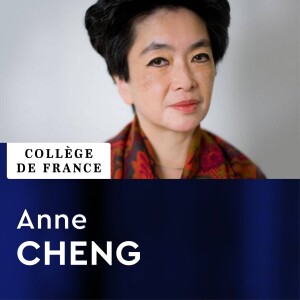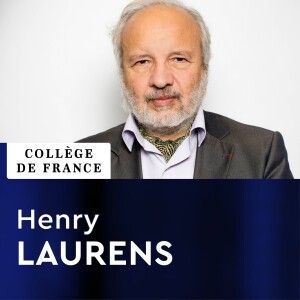

Histoire intellectuelle de la Chine - Anne Cheng
https://podcast.college-de-france.fr/xml2/cdf8-21.xmlEpisode List

Conférence - Egas Bender de Moniz Bandeira : Assimilation ou intégration ? La représentation de la Mongolie, du Tibet et du Xinjiang dans les parlements de l'Empire Qing et de la République de Chine
Anne ChengCollège de FranceHistoire intellectuelle de la ChineAnnée 2024-2025Conférence - Egas Bender de Moniz Bandeira : Assimilation ou intégration ? La représentation de la Mongolie, du Tibet et du Xinjiang dans les parlements de l'Empire Qing et de la République de ChineEgas Bender de Moniz BandeiraAssistant professeur à l'université d'Erlangen-Nürnberg, chercheur associé de l'Institut Max Planck de l'Histoire et Théorie du DroitRésuméDans cette présentation, j'examinerai la représentation de la Mongolie, du Tibet et du Xinjiang dans les parlements de la Chine du début du XXe siècle, notamment au sein du Conseil consultatif politique (Zizhengyuan 資政院) de la fin des Qing et de l'Assemblée nationale du début de la République. J'identifie deux modes distincts, mais entremêlés, de représentation des régions frontalières : un modèle patrimonial, qui maintenait les privilèges aristocratiques en échange de la loyauté, et un modèle d'État-nation, qui envisageait un statut égal pour les régions frontalières aux côtés des provinces à majorité Han. En reconstruisant ces deux modes de représentation parlementaire, cette intervention replacera les débats constitutionnels chinois dans un contexte eurasien plus large, montrant comment les tendances mondiales en matière de gouvernance ont croisé les efforts de la Chine pour assimiler ses populations frontalières diverses dans un État-nation unitaire.Depuis la formation de l'Empire Daicing (Qing) aux XVIIe et XVIIIe siècles, ces régions étaient administrées selon des arrangements distincts des provinces. La Mongolie et le Tibet restaient sous la juridiction du ministère des Affaires des régions extérieures (Lifan yuan 理藩院). Le Xinjiang fut officiellement érigé en province en 1884, mais continua d'être traité sous de nombreux aspects comme un territoire frontalier. Lorsque le gouvernement Qing annonça sa « réforme de gouvernance » dans les années 1900, le statut des confins joua un rôle central dans les débats sur l'adoption d'une constitution impériale. J'expose comment le parlement fut conçu comme un instrument d'unification nationale plutôt que comme un moyen de représenter la diversité impériale. Par ailleurs, les intellectuels et fonctionnaires chinois, conscients de la concurrence des institutions parlementaires émergentes en Russie et dans l'Empire ottoman, craignaient que des mouvements constitutionnels et parlementaristes chez les Mongols, les Tibétains et les Musulmans ne conduisent à la séparation de ces régions si l'Empire Qing ne menait pas de réformes similaires. Ils espéraient donc que la représentation parlementaire puisse servir d'outil contre les tendances centrifuges aux frontières.Toutefois, ils refusèrent l'application directe du cadre constitutionnel aux territoires frontaliers, invoquant leur faible densité de population ainsi que leur prétendue arriération économique et culturelle. À la place, ils proposèrent de les représenter par des sièges nommés dans la nouvelle chambre haute du parlement. Le Xinjiang constituait un hybride entre une province qui devait, au moins formellement, se conformer aux mêmes standards que les autres provinces, et une région frontalière qui n'était pas considérée comme égale aux provinces intérieures. Parce que le Xinjiang était officiellement une province, il possédait, en théorie, une assemblée provinciale, bien que celle-ci n'ait pas organisé d'élections et qu'aucun délégué élu n'ait été envoyé au Conseil consultatif politique à Pékin. Parallèlement, il était également représenté dans le cadre du « constitutionnalisme frontalier » par deux nobles nommés siégeant dans l'embryon de chambre haute. Ces politiques différenciées cherchaient essentiellement à parlementariser le modèle patrimonial des Qing, qui accordait des privilèges à la noblesse frontalière en échange de sa fidélité. Cependant, ces compromis laissèrent toutes les parties insatisfaites.Les défis posés par la proclamation de la République de Chine, en particulier les déclarations d'indépendance de la Mongolie et du Tibet, conduisirent à une insistance accrue sur l'unité du nouvel État et à l'adoption rapide du modèle de l'État-nation. Dans la nouvelle « République des Cinq Ethnies » (wuzu gonghe 五族共和), le Tibet et les régions mongoles bénéficièrent d'une représentation à la fois dans la chambre haute et dans la chambre basse. Toutefois, en analysant les écrits des premiers juristes constitutionnels républicains et les débats au sein du Sénat républicain naissant, je montre que ce choix ne fit pas l'unanimité. De plus, diverses modifications et exceptions insérées dans la loi électorale firent en sorte que la participation électorale ne fût pas strictement territoriale, mais releva une fois de plus d'un système différencié de représentation frontalière.

Conférence - Naoko Shimazu : Symbolic Diplomacy: Tojo and the 1943 Tokyo Conference
Anne ChengCollège de FranceHistoire intellectuelle de la ChineAnnée 2024-2025Conférence - Naoko Shimazu : Symbolic Diplomacy: Tojo and the 1943 Tokyo ConferenceNaoko ShimazuProfessor and Deputy Director, Tokyo CollegeNaoko Shimazu est invitée par l'assemblée du Collège de France sur proposition de la Pr Anne Cheng.RésuméThe Greater East Asia Conference was held on 5 and 6 November 1943 in Tokyo, under the chairmanship of Prime Minister General Tōjō Hideki. Variously known as the Tokyo Conference, the Greater East Asia Congress, or the Assembly of East Asiatic Nations, the conference gathered the five 'independent' states of the Manchukuo, Reorganised National Government of China (the Nanjing Regime), the Philippines, Burma, and Thailand within the Greater East Asia Co-Prosperity Sphere, to show a united front against the Allied powers, and most importantly, to confirm the establishment of the Greater East Asia Co-Prosperity Sphere. It was the only large-scale diplomatic pageantry held in wartime Japan that attempted to make some diplomatic capital out of its short-lived Co-Prosperity Sphere. This lecture offers a novel perspective on this conference by privileging 'performance' as an analytical prism and consider the role of the emotive or the 'affect' in international diplomacy. This presentation which examines the Greater East Asia Conference of 1943 as a symbolic performance, represents two overarching intellectual enquiries I have: first to examine competing notions of 'Asia' at key historical junctures in twentieth-century Asia; second, to develop and apply an interdisciplinary methodological framework that can explain symbolic meanings in politics and diplomacy, in order to illustrate how 'Asia' came to be envisioned and enacted. In the end, we shall discover that Tojo was both the choreographer and the dancer/actor of the show that became emblematic of his notion of Greater East Asia. Indeed, the multiple role-playing of Tojo, and the importance he attached to it, becomes pivotal to our understanding of this particular story.

Conférence - Naoko Shimazu : Japan at the 1919 Paris Peace Conference
Anne ChengCollège de FranceHistoire intellectuelle de la ChineAnnée 2024-2025Conférence - Naoko Shimazu : Japan at the 1919 Paris Peace ConferenceWar and Peace: A Global History of Japan, 1904-1943Naoko ShimazuProfessor and Deputy Director, Tokyo CollegeNaoko Shimazu est invitée par l'assemblée du Collège de France sur proposition de la Pr Anne Cheng.RésuméIt is not well known that Japan fought as one of the Allied powers in the First World War, as Japan was a naval alliance partner of Britain from 1902. At the Paris Peace Conference of 1919, Japan attended it as the fifth largest great power in the world, after the United States, Britain, France and Italy, represented by high profile statesmen – Woodrow Wilson, David Lloyd-George, Georges Clemenceau and Vittorio Orlando. This lecture situates Japan in the world in 1919, and what the peace conference had meant for Japanese politics and foreign policy in the 1920s and beyond. What is most striking about the Japanese participation at Paris was that it proposed a racial equality proposal to be inserted into the League of Nations Covenant which was drafted in the League of Nations Committee headed by the American president Woodrow Wilson. Why did the Japanese delegation propose a principle of international justice? The lecture will offer explanations as to why the Japanese wanted to submit this proposal, and the long and difficult negotiation it had to endure in the process. What the Japanese had not realized was that this proposal had been misconstrued by the British Empire delegation, especially the Australian premier Billy Hughes who insisted on blocking it by arguing that it amounted to free immigration of all peoples into Australia and other settler territories.

Conférence - Naoko Shimazu : The Making of a Heroic War Myth in Modern Japan
Anne ChengCollège de FranceHistoire intellectuelle de la ChineAnnée 2024-2025Conférence - Naoko Shimazu : The Making of a Heroic War Myth in Modern JapanWar and Peace: A Global History of Japan, 1904-1943Naoko ShimazuProfessor and Deputy Director, Tokyo CollegeNaoko Shimazu est invitée par l'assemblée du Collège de France sur proposition de la Pr Anne Cheng.RésuméHeroic war myths are an integral aspect of war in any cultural tradition. In modern warfare, the primary objective of heroic war myth is to arouse patriotic sentiment in order to mobilise the nation to fight an efficient and winning war. Modern Japan was no exception. Within Japan, the most powerful official heroic myth created from the Russo-Japanese war was Commander Takeo Hirose who died in the second blockade of Port Arthur on 27 March 1904. Within a few days of his death, Commander Hirose even began to assume the title of the 'God of War Commander Hirose' (Gunshin Hirose chūsa). In this lecture, we trace step by step how the myth of the 'God of War Commander Hirose' was created by the Naval History Section of the Japanese Imperial Navy as it started looking for a suitable individual as soon as the war started in February 1904. 'God of War Commander Hirose' became a household name and his appeal was such that many cultural outputs were created, such as a kabuki play, a Western style theatre play, commercial films, for instance. The Hirose myth reached its apogee in 1935 when the commander was venerated as a god of war in a shrine named after him – Hirose Shrine established in his native hometown in Oita Prefecture.

Conférence - Naoko Shimazu : Japanese War Diaries from the Russo-Japanese War
Anne ChengCollège de FranceHistoire intellectuelle de la ChineAnnée 2024-2025Conférence - Naoko Shimazu : Japanese War Diaries from the Russo-Japanese WarWar and Peace: A Global History of Japan, 1904-1943Naoko ShimazuProfessor and Deputy Director, Tokyo CollegeNaoko Shimazu est invitée par l'assemblée du Collège de France sur proposition de la Pr Anne Cheng.RésuméThe Russo-Japanese War of 1904-5 was the first modern warfare of the twentieth century. Japan won the war against Russia which had the largest land army in the world at the time. In this lecture, we focus on the personal war diaries of Japanese conscripts who had been conscripted from all over the country, and mobilised to fight against the Russians in the northeastern provinces of China. Contrary to the official narrative of 'honorable war death' where Japanese soldiers were supposed to have found honour in dying for the country, conscript diaries told entirely different stories. Many of the conscripts came from poor rural areas and were bread winners of their families. They wrote about their profound sadness in leaving their elderly parents back home, and their desire of surviving the war and return without injuries. We also learn about their attitude towards death on battlefields, when they witnessed and engaged in the business of fighting and killing as soldiers. Their diaries reveal the process of brutalisation in war as conscripts became accustomed to seeing death everywhere on battlefield. In all, conscripts diaries offers a rare glimpse into the emotional world of a conscript and how they processed their desftiny of dying for the state. In turn, such an insight enables us to have a better understanding of Japanese attitudes towards death.
You may also like
Create Your Podcast In Minutes
- Full-featured podcast site
- Unlimited storage and bandwidth
- Comprehensive podcast stats
- Distribute to Apple Podcasts, Spotify, and more
- Make money with your podcast












